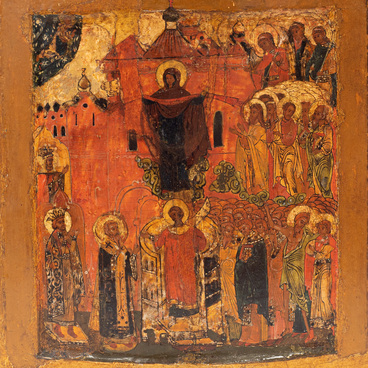The Kazan Icon of the Mother of God is one of the icons of Saint Nicholas Church in the village of Kovda, Murmansk region, an important monument of northern wooden architecture. Kovda is one of the first settlements on the White Sea. It was founded on the river Kovda.
At the end of the 19th century, the village of Kovda was a relatively large port that was connected with many Scandinavian countries and the Russian North. Today, about 20 people live in Kovda, and the houses have become summer holiday cottages.
The ancient Saint Nicholas Church, which was mentioned in the late 15th century, was burnt down by the Swedes in the late 16th century. In 1705, the contemporary Saint Nicholas Church was built on the site of the old one. This wooden church belonged to the klet type — it was a log house with a two-tier gable roof and a dome with a cross. The total height was 14.3 meters.
The church is dedicated to Saint Nicholas the Wonderworker, Archbishop of Myra in Lycia. Being the patron saint of sailors, hunters, and fishermen, he was especially revered in the Kola Peninsula. Those caught in sea storms always prayed to St. Nicholas for help. Almost every Pomor village had a church and a chapel dedicated to Nicholas the Wonderworker.
The Kovda church was closed in 1960. There was a research expedition that was organized that year. As a result, some icons were taken away and brought to various locations where they were to be stored. The rest of the Kovda icons had been remaining in the closed church building for almost 30 years. The icons were painted between the 17th and 19th centuries. They illustrate the features and plots that were most common in the Russian North.
In 1992, the icons were removed for restoration, and afterward they were donated to the Murmansk Regional Art Museum. The restorers cleaned the icon of later overpaint, built up the lost areas of paint and retained the general look of the work was preserved, as it has been preserved to the present day. The Kazan image of the Mother of God has a number of particular characteristics: the Virgin is represented by the full-face view, this is a shoulder-length image, the Mother of God wears special clothes, and her head leans lightly towards the Child. The Infant Jesus, who is represented by the full-face view, is seated on her left hand, and she holds her right hand in a blessing gesture. The eyes of the Mother and Child are directed right at the praying person.
At the end of the 19th century, the village of Kovda was a relatively large port that was connected with many Scandinavian countries and the Russian North. Today, about 20 people live in Kovda, and the houses have become summer holiday cottages.
The ancient Saint Nicholas Church, which was mentioned in the late 15th century, was burnt down by the Swedes in the late 16th century. In 1705, the contemporary Saint Nicholas Church was built on the site of the old one. This wooden church belonged to the klet type — it was a log house with a two-tier gable roof and a dome with a cross. The total height was 14.3 meters.
The church is dedicated to Saint Nicholas the Wonderworker, Archbishop of Myra in Lycia. Being the patron saint of sailors, hunters, and fishermen, he was especially revered in the Kola Peninsula. Those caught in sea storms always prayed to St. Nicholas for help. Almost every Pomor village had a church and a chapel dedicated to Nicholas the Wonderworker.
The Kovda church was closed in 1960. There was a research expedition that was organized that year. As a result, some icons were taken away and brought to various locations where they were to be stored. The rest of the Kovda icons had been remaining in the closed church building for almost 30 years. The icons were painted between the 17th and 19th centuries. They illustrate the features and plots that were most common in the Russian North.
In 1992, the icons were removed for restoration, and afterward they were donated to the Murmansk Regional Art Museum. The restorers cleaned the icon of later overpaint, built up the lost areas of paint and retained the general look of the work was preserved, as it has been preserved to the present day. The Kazan image of the Mother of God has a number of particular characteristics: the Virgin is represented by the full-face view, this is a shoulder-length image, the Mother of God wears special clothes, and her head leans lightly towards the Child. The Infant Jesus, who is represented by the full-face view, is seated on her left hand, and she holds her right hand in a blessing gesture. The eyes of the Mother and Child are directed right at the praying person.



